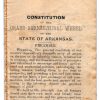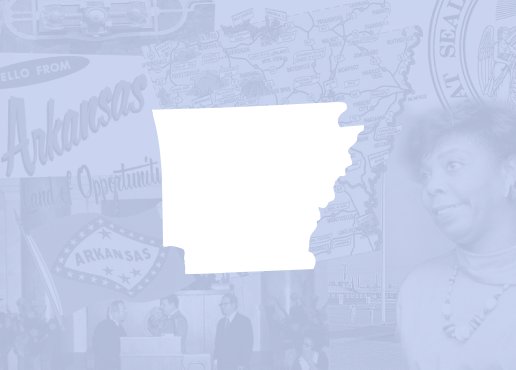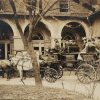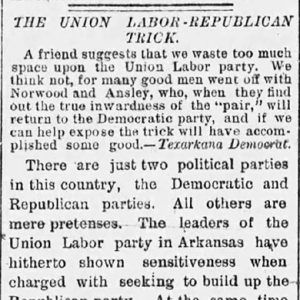calsfoundation@cals.org
Union Labor Party
The Union Labor Party (ULP) participated in only two election years in Arkansas (1888 and 1890), yet during that brief span, it mounted the most serious challenge that the state’s Democratic Party faced between the end of Reconstruction and the rebirth of the Republican Party in the mid-1960s. The ULP appealed to farmers and industrial workers and drew significant support from white and black voters alike. The party’s failure to topple the Democrats from power underscored the failure of democracy itself in Arkansas while shedding light on some of the ugliest episodes in the history of American politics.
Origins
The national Union Labor Party was formed in Cincinnati, Ohio, in February 1887 by some 300 to 600 delegates at a convention called the Industrial Labor Conference. The party’s founders included members of the Knights of Labor, the Agricultural Wheel, the Farmers’ Alliance, the declining Grange, and the defunct Greenback Party. Each of these organizations was or had been active in Arkansas, and, along with the earlier farmers’ organization the Brothers of Freedom, they helped lay the groundwork for farmer-labor third-party political activity during the late 1870s and 1880s. In 1886, the Agricultural Wheel nominated Charles Cunningham, a former Arkansas Grange leader and Greenback congressional candidate, for governor. (He received a scant twelve percent of the vote.) The Agricultural Wheel and the Knights of Labor, many of whose members were galvanized by a failed railroad strike against Jay Gould’s Southwestern system that spring, both put forth or openly supported third-party or independent candidates in local or congressional races that year, despite their claims to be nonpartisan organizations. In some instances, the two organizations engaged in unofficial cooperation in these endeavors. The ULP became the vehicle for both organizations to enter politics more fully without further undermining the nonpartisanship called for in their constitutions.
ULP Campaigns and Accomplishments
In Little Rock (Pulaski County) on April 30, 1888, the Arkansas ULP held its first state convention—which drew representatives (including some African Americans) from the Knights of Labor, the Agricultural Wheel, and the Farmers’ Alliance—and endorsed the platforms of each of these organizations. The convention nominated Charles M. Norwood, a one-legged Confederate veteran, for governor. Norwood condemned Democratic Party corruption and what he characterized as that party’s orientation toward the interests of banks and businessmen at the expense of farmers and laborers. The Republican Party supported Norwood rather than nominating its own candidate. When Norwood lost to Democrat James P. Eagle by 15,000 votes out of more than 180,000 ballots counted, Union Laborite Reuben CarlLee wrote a letter, subsequently published in the Arkansas Gazette, in which he made detailed allegations of Democratic intimidation, murder, and fraud, denouncing “the fraudulent state government of Arkansas.” ULP (and Republican) congressional candidates faced similar challenges later that fall. ULP candidate Lewis P. Featherstone won a seat as the congressional representative from the First Congressional District of eastern Arkansas—but only after filing charges of election fraud with the U.S. House of Representatives. Republican John Clayton also filed charges of fraud in the case of his narrow defeat in the Second Congressional District, but he was assassinated in Conway County while gathering evidence for his case. Arkansas elections followed the same deplorable pattern in 1890, with ULP candidates losing again by narrow and suspect margins, but none of them attempted to challenge the official results this time.
During his brief term in Congress, Featherstone introduced several bills on behalf of the Arkansas Farmers’ Alliance and Agricultural Wheel, primarily intended to provide economic relief to beleaguered farmers and protection for the prices of the goods they produced. In the Arkansas General Assembly, ULP representatives fought for election reform, railroad regulation, antitrust legislation, and credit reform, but with only fourteen seats (by the highest count), they lacked the strength of numbers to accomplish these goals. Republican representatives did not always support the ULP agenda, despite the GOP’s support for ULP gubernatorial and (in some instances) congressional candidates.
Demise
After the formation of the national People’s (or Populist) Party during 1891–1892, the Arkansas ULP ceased to exist as it submerged itself into the new party, with many of the same leaders and essentially the same platform. But the state’s “election reform” law of 1891 disfranchised many black and poor white voters who had been essential to the ULP’s strength at the polls. A state poll tax approved by voters in 1892 further decimated any prospect of third-party success, as did the decision of GOP leaders to resume the nomination of Republican gubernatorial candidates. Therefore, the Arkansas Populist Party never achieved the same level of electoral support that the ULP had, and the party disintegrated by the end of the decade. With it vanished the hopes of a biracial (though white-led) coalition of poor-to-middle-class farmers and laborers that, in a more democratic setting, might well have brought a measure of economic and social justice to the residents of Arkansas who needed it most.
For additional information:
Barnes, Kenneth C. Who Killed John Clayton? Political Violence and the Emergence of the New South, 1861–1893. Durham, NC: Duke University Press, 1998.
Graves, John William. Town and Country: Race Relations in an Urban-Rural Context, 1865–1905. Fayetteville: University of Arkansas Press, 1990.
Hild, Matthew. Arkansas’s Gilded Age: The Rise, Decline, and Legacy of Populism and Working-Class Protest. Columbia: University of Missouri Press, 2018.
———. Greenbackers, Knights of Labor, and Populists: Farmer-Labor Insurgency in the Late-Nineteenth-Century South. Athens: University of Georgia Press, 2007.
———. “Labor, Third-Party Politics, and New South Democracy in Arkansas, 1884–1896.” Arkansas Historical Quarterly 63 (Spring 2004): 24–43.
McCollom, Jason. “The Agricultural Wheel, the Union Labor Party, and the 1889 Arkansas Legislature.” Arkansas Historical Quarterly 68 (Summer 2009): 157–175.
Moneyhon, Carl H. Arkansas and the New South, 1874–1929. Fayetteville: University of Arkansas Press, 1997.
Paisley, Clifton. “The Political Wheelers and Arkansas’ Election of 1888.” Arkansas Historical Quarterly 25 (Spring 1966): 3–21.
Wheeler, John M. “The People’s Party in Arkansas, 1891–1896.” PhD diss., Tulane University, 1975.
Matthew Hild
Georgia Institute of Technology



 Union Labor Party Article
Union Labor Party Article 



Comments
No comments on this entry yet.